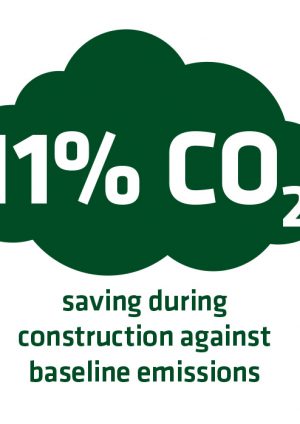
Crossrail Construction Carbon Model
Document
type: Micro-report
Author:
Navid Hojjati, Mike de Silva BSc PhD FCIWEM MIEEM CSci C.WEM
Publication
Date: 27/09/2016
-
Abstract
Crossrail’s carbon footprint development and measurement provides a benchmark for future rail projects. A spreadsheet based tool was developed to measure the overall carbon footprint through Scope 1,2,3 in construction and also over 120 years of operation. A further tool, described in this micro-report, was developed to forecast and monitor the ongoing construction carbon footprint (Scopes 1 & 2) to enable the project to determine if it was on target to achieve its target reduction. The Manual and Excel based models for both are included as supporting documents.
-
Read the full document
Crossrail Construction Carbon Model
The Crossrail carbon model template was originally designed by Riyadh Reaid (Placement Student) & Robin Underwood (Graduate) under direction from Mike de Silva to enable contractors to report their carbon emissions very accurately and consistently, with lowest human error and importantly to predict the end of construction carbon and expected reduction from the baseline through the implementation of reduction measures. Substantial improvements were subsequently made by Navid Hojati (Graduate). The validation mechanism embedded in the model enables the reviewers to quickly identify the areas that might be an issue and therefore complete the review process faster and more efficiently.
The model is made of a series of tabs which fall into five main categories including:
- Informative tabs: The first three tabs of the model give information on using the model, the result of calculations, summary of the model and validation of the entered data.
- Initiatives: the next seven tabs are designed for capturing the carbon saving initiatives including efficient fuel equipment, efficient site offices, lighting solutions etc.
- Actual data entry: two tabs are provided to capture the actual energy consumption.
- Reference/Evidence: Two tabs are provided for capturing all of the references and evidence that support the claimed savings.
- Calculation tabs: These are a series of hidden tabs where the actual calculations take place. Also the comprehensive breakdowns on carbon emissions are generated in one of those tabs which can be used for detailed reporting purposes.
During the development stage of this model and implementing it across the project there was many issues and difficulties through addressing which the following lessons were learnt.
Lessons learned and recommendations for future projects
- Reporting carbon emissions in a consistent format and method across the whole program should be a contractual requirement from the start of the project. It will help to:
- Have a valid comparison between all contracts
- Save a lot of time in interpreting the provided data
- Have a consistent method of calculation across the project and therefore comparable figures.
- Significantly reduce the labour hours required for generating periodic reports on results
- A comprehensive carbon model template should be created from the start of project. It must be designed in a way that every contract can use it regardless of their nature of work. This will prevent future changes to the model and keeps the consistency of the provided data. Various types of contracts include but are not limited to:
- Station contracts
- Civil contracts (shafts, portals etc.)
- Systemwide contracts
- Tunnelling contracts
- Transportation Contracts.
- A robust method for calculating carbon savings for Green tariffs, using Clean fuels like biodiesel and using power factor correction equipment should be embedded into the model. This prevents future debates and reduces the need for contractual changes.
- Contractors must obtain sufficient information on the carbon content of the energy they buy from the energy provider company, when they make an energy purchase contract. It then can be fed into the model.
- Contractors should be informed about the benefits of being on a particular energy tariff so they can make informed decisions when buying energy.
- Monitoring and collecting comprehensive data on the material delivered on site and their carbon content must be a contractual requirement. For instance, concrete production companies can provide certificates or datasheets that clearly shows the amount of carbon embodied in their specific concrete mixes. Such information must be obtained for all materials (specifically steel and concrete) and be reported regularly within the carbon model.
- Excel spreadsheets are preferred for establishing the model comparing to the web based models. This is because of the flexibility it provides for future changes that can be managed by any person even with limited IT knowledge. However, it is strongly advised to lock the areas that are not meant to be changed by users. This is very important and can save many hours spent on fixing unintentional changes.
- The source of GHG factors for various fuel types should be agreed and be consistent across the whole program. There were instances that different contractors we using various GHG values for an identical fuel because they were using different sources including DEFRA, DECC, etc. Therefore having an agreement in place to define the source would be a more consistent approach.
- The designed carbon model should be user friendly and self explanatory so everyone can input data without risk of error. It can be achieved by putting data entry restrictions and validation measures in place to reduce the risk of human error.
Designing a tab for generating output data in a suitable format to consolidate all of the individual reports into one comprehensive program-wide report would save a lot of time and improves the consistency and accuracy of monitoring the project performance.
-
Document Links
-
Authors
Navid Hojjati - Crossrail Ltd
Navid is a mechanical engineer who also has a master’s degree in project management. Navid has one year of project management experience in designing and building an electric vehicle. He also worked as an assistant engineering manager in the oil industry for one year. After finishing his master’s degree, he started working for Crossrail as a graduate engineer. Graduate placement roles have included assistant engineering manager at Liverpool Street Station, Quality team and the Sustainability and Consents team where he further developed Crossrail’s construction energy models and also supported research into grout shaft repurposing for ground source heat extraction.
Mike de Silva BSc PhD FCIWEM MIEEM CSci C.WEM - Bechtel
Sustainability Manager
Mike has over 25 years of environmental and sustainability design and construction experience much of which has been gained in the rail industry. He has worked on the two largest rail link projects in the United Kingdom, Crossrail and High Speed 1. Mike worked as Sustainability Manager on the Crossrail between 2009 and 2017 and was responsible for delivering its sustainability strategy and reporting as well as leading on CEEQUAL and BREEAM project management, and had an assurance role on the management & measurement of the project’s carbon footprint. He is currently working on HS2 Phase 2b.
He is well known in the industry and has published a number of works including the well reviewed Royal Institute of Chartered Surveyors publication “Sustainability & the Property Lifecycle”. He has also sat on a number of working groups including CEEQUAL International, BREEAM Infrastructure and BES6001 a voluntary standard on responsible sourcing of construction materials & products, and is currently on the editorial panel for the ICE Journal, Engineering Sustainability.


